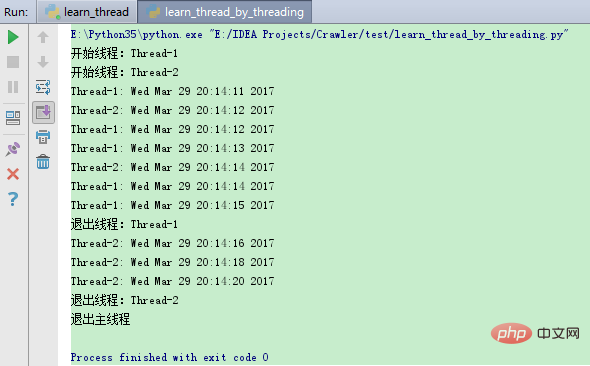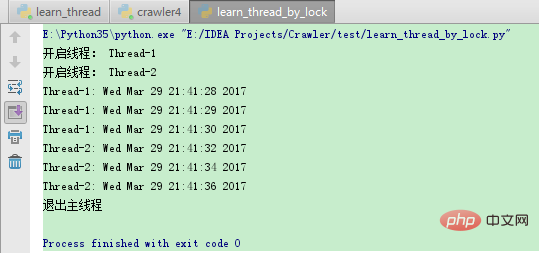帶你一起解讀Python多線程
- WBOYWBOYWBOYWBOYWBOYWBOYWBOYWBOYWBOYWBOYWBOYWBOYWB轉載
- 2022-03-02 17:35:482619瀏覽
本篇文章為大家帶來了關於python的相關知識,其中主要介紹了關於多線程的相關知識,多線程類似於同時執行多個不同的程序,有很多的優點,下面我們就來看一下,希望對大家有幫助。

推薦學習:python教學
#執行緒講解
多執行緒類似於同時執行多個不同程序,多執行緒運行有以下優點:
- 使用執行緒可以把佔據長時間的程式中的任務放到後台去處理。
- 使用者介面可以更吸引人,這樣例如使用者點擊了一個按鈕去觸發某些事件的處理,可以彈出一個進度條來顯示處理的進度。
- 程式的運作速度可能加快。
- 在一些等待的任務實作上如使用者輸入、檔案讀寫和網路收發資料等,執行緒就比較有用了。在這種情況下我們可以釋放一些珍貴的資源如記憶體佔用等等。
執行緒在執行過程中與行程還是有區別的。每個獨立的執行緒都有一個程式運行的入口、順序執行序列和程式的出口。但是執行緒不能夠獨立執行,必須依存在應用程式中,由應用程式提供多個執行緒執行控制。
每個執行緒都有他自己的一組CPU暫存器,稱為執行緒的上下文,該上下文反映了執行緒上次運行該執行緒的CPU暫存器的狀態。
指令指標和堆疊指標暫存器是執行緒上下文中兩個最重要的暫存器,執行緒總是在進程的上下文中運行的,這些位址都用於標誌擁有線程的進程地址空間中的記憶體。
線程可以被搶佔(中斷)。
在其他執行緒正在執行時,執行緒可以暫時擱置(也稱為睡眠) – 這就是執行緒的退讓。
執行緒可以分為:
- 核心執行緒:由作業系統核心建立和撤銷。
- 使用者執行緒:不需要核心支援而在使用者程式中實現的執行緒。
Python3 執行緒中常用的兩個模組為:
- _thread
- threading(建議使用)
thread模組已被廢棄。使用者可以使用 threading 模組代替。所以,在 Python3 中不能再使用"thread" 模組。為了相容性,Python3 將 thread 重新命名為 “_thread”。
開始學習Python線程
Python中使用線程有兩種方式:函數或用類別來包裝線程物件。
函數式:呼叫 _thread 模組中的start_new_thread()函數來產生新執行緒。語法如下:
_thread.start_new_thread ( function, args[, kwargs] )
參數說明:
- function - 執行緒函數。
- args - 傳遞給執行緒函數的參數,他必須是個tuple類型。
- kwargs - 可選參數。
實例:
#!/usr/bin/python3 import _thread import time # 为线程定义一个函数 def print_time( threadName, delay): count = 0 while count <p> 執行以上程式輸出結果如下:<br><img src="/static/imghwm/default1.png" data-src="https://img.php.cn/upload/article/000/000/067/9e54370fdafb34f8739135c680e1aa53-0.png" class="lazy" alt="帶你一起解讀Python多線程"></p>##執行緒模組<h2></h2># Python3 透過兩個標準庫_thread 和threading 提供對執行緒的支援。 <p></p>
- _thread 提供了低階的、原始的執行緒以及一個簡單的鎖,它相比於 threading 模組的功能還是比較有限的。
- threading 模組除了包含 _thread 模組中的所有方法外,還提供的其他方法:
- threading.currentThread(): 傳回目前的執行緒變數。
- threading.enumerate():
- 傳回一個包含正在執行的執行緒的list。正在執行指執行緒啟動後、結束前,不包含啟動前和終止後的執行緒。
threading.activeCount(): - 傳回正在執行的執行緒數量,與len(threading.enumerate())有相同的結果。
- run(): 用以表示線程活動的方法。
- start():啟動執行緒活動。
- join([time]): 等待至執行緒中止。這會阻塞呼叫執行緒直至執行緒的join()
- 方法被呼叫中止-正常退出或拋出未處理的例外-或者是可選的逾時發生。
isAlive(): 傳回執行緒是否活動的。 - getName(): 傳回執行緒名稱。
- setName(): 設定執行緒名。
#!/usr/bin/python3
import threading
import time
exitFlag = 0
class myThread (threading.Thread):
def __init__(self, threadID, name, counter):
threading.Thread.__init__(self)
self.threadID = threadID
self.name = name
self.counter = counter
def run(self):
print ("开始线程:" + self.name)
print_time(self.name, self.counter, 5)
print ("退出线程:" + self.name)
def print_time(threadName, delay, counter):
while counter:
if exitFlag:
threadName.exit()
time.sleep(delay)
print ("%s: %s" % (threadName, time.ctime(time.time())))
counter -= 1
# 创建新线程
thread1 = myThread(1, "Thread-1", 1)
thread2 = myThread(2, "Thread-2", 2)
# 开启新线程
thread1.start()
thread2.start()
thread1.join()
thread2.join()
print ("退出主线程") 以上程式執行結果如下: #
#
线程同步
如果多个线程共同对某个数据修改,则可能出现不可预料的结果,为了保证数据的正确性,需要对多个线程进行同步。
使用 Thread 对象的 Lock 和 Rlock 可以实现简单的线程同步,这两个对象都有 acquire 方法和 release 方法,对于那些需要每次只允许一个线程操作的数据,可以将其操作放到 acquire 和 release 方法之间。如下:
多线程的优势在于可以同时运行多个任务(至少感觉起来是这样)。但是当线程需要共享数据时,可能存在数据不同步的问题。
考虑这样一种情况:一个列表里所有元素都是0,线程"set"从后向前把所有元素改成1,而线程"print"负责从前往后读取列表并打印。
那么,可能线程"set"开始改的时候,线程"print"便来打印列表了,输出就成了一半0一半1,这就是数据的不同步。为了避免这种情况,引入了锁的概念。
锁有两种状态——锁定和未锁定。每当一个线程比如"set"要访问共享数据时,必须先获得锁定;如果已经有别的线程比如"print"获得锁定了,那么就让线程"set"暂停,也就是同步阻塞;等到线程"print"访问完毕,释放锁以后,再让线程"set"继续。
经过这样的处理,打印列表时要么全部输出0,要么全部输出1,不会再出现一半0一半1的尴尬场面。
实例:
#!/usr/bin/python3
import threading
import time
class myThread (threading.Thread):
def __init__(self, threadID, name, counter):
threading.Thread.__init__(self)
self.threadID = threadID
self.name = name
self.counter = counter
def run(self):
print ("开启线程: " + self.name)
# 获取锁,用于线程同步
threadLock.acquire()
print_time(self.name, self.counter, 3)
# 释放锁,开启下一个线程
threadLock.release()
def print_time(threadName, delay, counter):
while counter:
time.sleep(delay)
print ("%s: %s" % (threadName, time.ctime(time.time())))
counter -= 1
threadLock = threading.Lock()
threads = []
# 创建新线程
thread1 = myThread(1, "Thread-1", 1)
thread2 = myThread(2, "Thread-2", 2)
# 开启新线程
thread1.start()
thread2.start()
# 添加线程到线程列表
threads.append(thread1)
threads.append(thread2)
# 等待所有线程完成
for t in threads:
t.join()
print ("退出主线程")
执行以上程序,输出结果为:
线程优先级队列(Queue)
Python 的 Queue 模块中提供了同步的、线程安全的队列类,包括FIFO(先入先出)队列Queue,LIFO(后入先出)队列LifoQueue,和优先级队列 PriorityQueue。
这些队列都实现了锁原语,能够在多线程中直接使用,可以使用队列来实现线程间的同步。
Queue 模块中的常用方法:
- Queue.qsize() 返回队列的大小
- Queue.empty() 如果队列为空,返回True,反之False
- Queue.full() 如果队列满了,返回True,反之False
- Queue.full 与 maxsize 大小对应
- Queue.get([block[, timeout]])获取队列,timeout等待时间
- Queue.get_nowait() 相当Queue.get(False)
- Queue.put(item) 写入队列,timeout等待时间
- Queue.put_nowait(item) 相当Queue.put(item, False)
- Queue.task_done() 在完成一项工作之后,Queue.task_done()函数向任务已经完成的队列发送一个信号
- Queue.join() 实际上意味着等到队列为空,再执行别的操作
实例:
#!/usr/bin/python3
import queue
import threading
import time
exitFlag = 0
class myThread (threading.Thread):
def __init__(self, threadID, name, q):
threading.Thread.__init__(self)
self.threadID = threadID
self.name = name
self.q = q
def run(self):
print ("开启线程:" + self.name)
process_data(self.name, self.q)
print ("退出线程:" + self.name)
def process_data(threadName, q):
while not exitFlag:
queueLock.acquire()
if not workQueue.empty():
data = q.get()
queueLock.release()
print ("%s processing %s" % (threadName, data))
else:
queueLock.release()
time.sleep(1)
threadList = ["Thread-1", "Thread-2", "Thread-3"]
nameList = ["One", "Two", "Three", "Four", "Five"]
queueLock = threading.Lock()
workQueue = queue.Queue(10)
threads = []
threadID = 1
# 创建新线程
for tName in threadList:
thread = myThread(threadID, tName, workQueue)
thread.start()
threads.append(thread)
threadID += 1
# 填充队列
queueLock.acquire()
for word in nameList:
workQueue.put(word)
queueLock.release()
# 等待队列清空
while not workQueue.empty():
pass
# 通知线程是时候退出
exitFlag = 1
# 等待所有线程完成
for t in threads:
t.join()
print ("退出主线程")
以上程序执行结果:
推荐学习:python学习教程
以上是帶你一起解讀Python多線程的詳細內容。更多資訊請關注PHP中文網其他相關文章!

